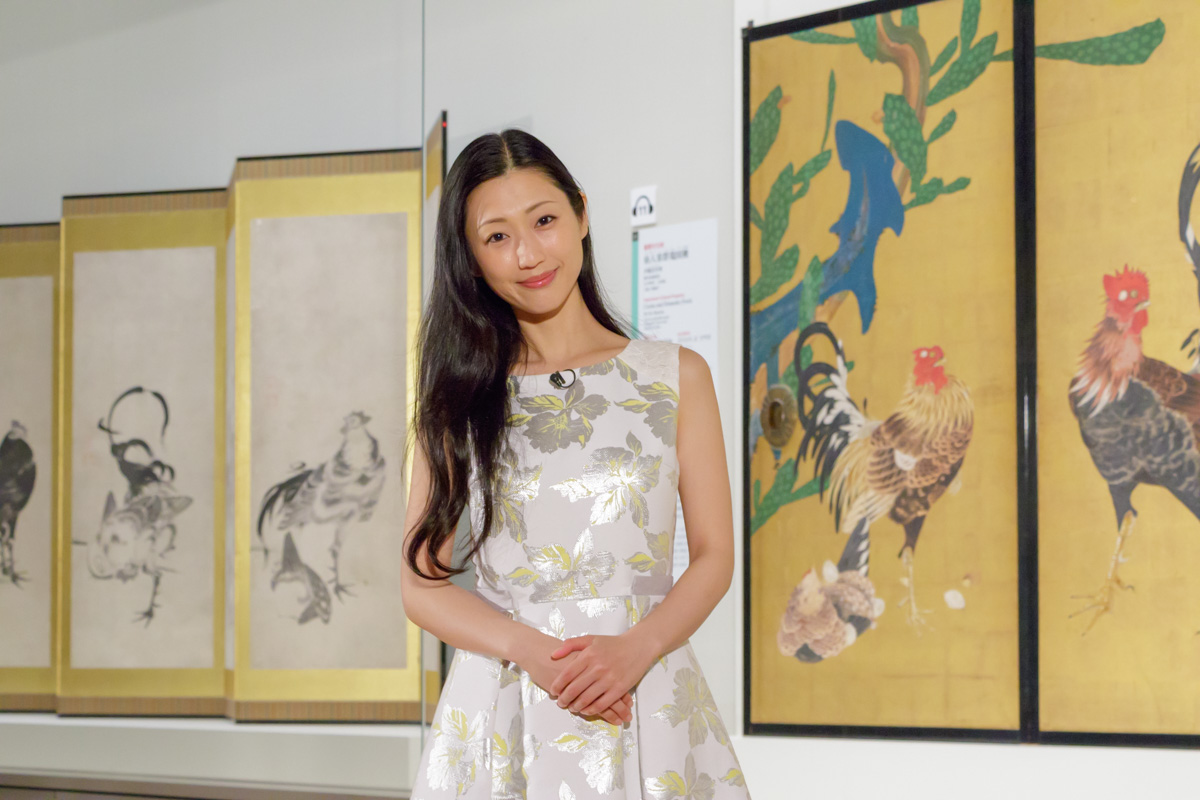
Ms. Danmitsu (talent) who served as a voice guide navigator for this exhibition.
From April 13 th (Fri) to May 27 th (Sun) of 2018, a special exhibition "Japanese art linking masterpieces -" will be held at the Tokyo National Museum Heiseikan. A press coverage was held on April 12th, so I will tell you the situation.
"Masterpieces" that shine brilliantly in the history of Japanese art. However, not only the phenomenal talent of so-called "genius painters" are those that produce masterpieces.
A special exhibition "Birth of masterpieces – Connecting arts in Japan" is an attempt to clarify "ties" that brought masterpieces and the story of their birth, paying attention to the influence relationship between common masterpieces representative of Japan and common social background is.
Approximately 130 works including national treasures and important cultural assets will be exhibited throughout the exhibition. To celebrate the 130th anniversary of the magazine 'Koka' and the 140th anniversary of the Asahi Shimbun, we specialize in arts and crafts born of classical literature such as Buddhist image of Jinggao and Genji Monogatari, as well as modern Western painting by Kishida Ryoji, region, era A number of "masterpieces" beyond time will gather together.
■ Exhibit composition
Chapter 2 Connection of Masters
Chapter 3 leading to classical literature
Chapter 4 Connecting motif / image
Let me introduce some of the venue landscape and some of the exhibited works.
Chapter 1 Connecting prayers
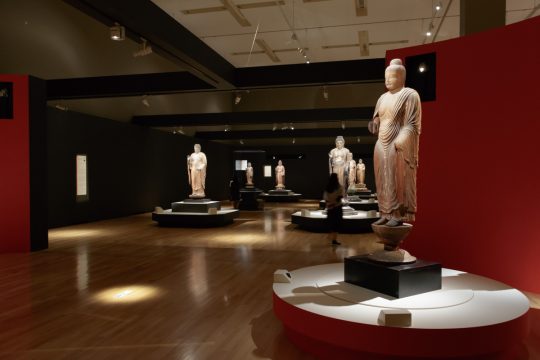
(Right picture) Important cultural heritage medicine Nagoro Standing statue Nara era 8th century Nara · Toshodaiji Temple Collection
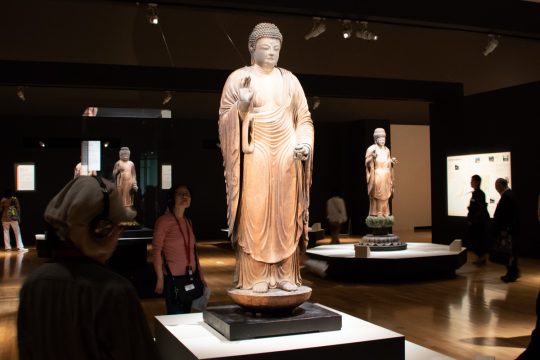
National Treasure Yakuin Nyoro Standing Stone Nara – Heian Period 8th – 9th Centuries Nara – Gensoji Temple
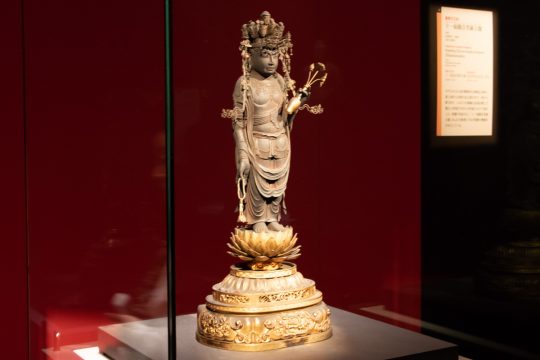
Important Cultural Property Ten faces Kannon Bodhisattva Statue Nara era 8 th century Osaka · Dojoji warehouse
When entering the venue, Buddha statues of one wooden (a technique to dig a whole body from one timber) line up and invite us to the world of quiet prayer.
While Buddha's appearance is based on Scripture, masterpieces with innovative techniques and impressive shaping are inherited and lead to the birth of further masterpieces. In Chapter 1, we focus on the statues of wooden sculptures of Nara and Heian, Female Bodhisattva statues, Anthropomorphic paintings drawn on the big screen, and introduce the "form of prayer" of people who have been handed down from the ancient times to the Middle Ages I will.
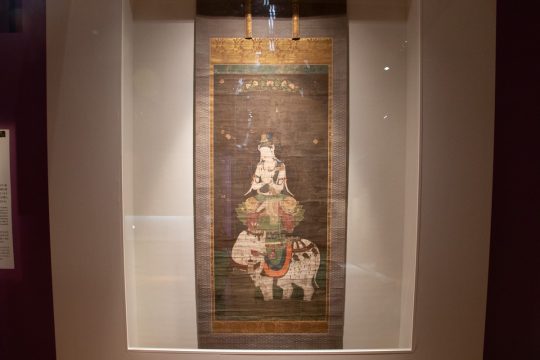
National Treasures Female Bodhisattva Heian period Collection of the 12th century Tokyo National Museum [exhibition period: April 13 to May 6]
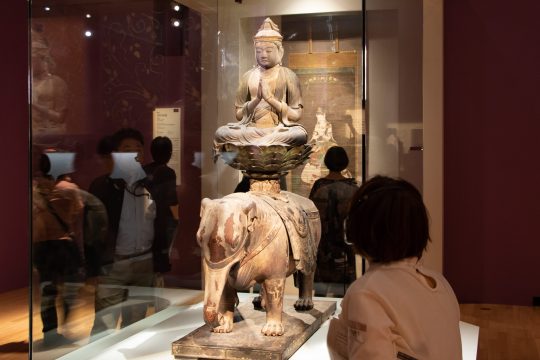
National Treasures Fumimasu Bodhisattva Cavalieri Heian era Heian period 12th century Tokyo · Okura collection Kobancho collection
In the corner of 'Fumimati praying' introducing genealogies of Fumosu Bodhisattva drawn in the form of chapters, the picture of "Female Bodhisattva statue" and the sculpture "Female Bodhisatz Occasion Image" all corrupt. Both are national treasures, it is a very valuable exhibition.
Female bodhisattva is the bodhisattva that emerges from the east to relieve what keeps the "Lotus Sutra". There are two major depictions of its appearance, one of which is seen in Horyuji Temple Kanedo mural painting, with the right hand twisting in front of the chest and having a lotus stem with the left hand, and the other is featured in this exhibition It is a figure that will hold hands together.
Chapter 2 Connection of Masters
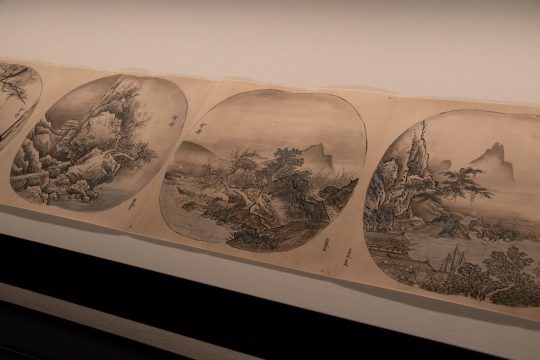
Booklet (Handbook) [Original] Sanko et al. Yokosuka, Kano Kanetsu Edo period 17th century Tokyo National Museum of Korea [exhibition period: April 13 to May 6]
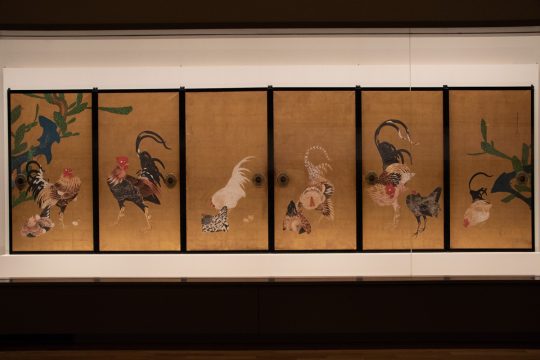
Important Cultural Property Seperate Group Chicken Chart Fusuma Ito Wakaku Pencil Edo Period 18th Century Osaka · Sai Fukuji Collection
Mr. Yasuhiro Sato, a professor at the University of Tokyo who gave an explanation of the exhibition at the exhibition, said, "These days, they are called" cat creatures "" genius painters "" genius painters ", but I want to eradicate this designation Haha). Did not an artist be an effort? "
A masterpiece is not created suddenly by a genius but it is born from the accumulation of history and the repetition of imitation and searching. In this chapter, we will focus on the three "master" such as Sesshu etc. Yang, Tawaraya Munezu, Ito Jakuchu, we will approach the process by which the master of Japanese art history learned and succeeded in the work of the predecessor.
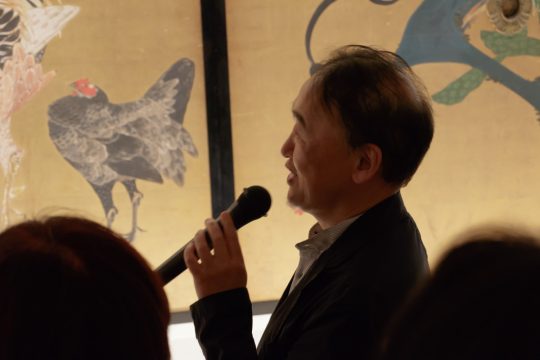
Yasuhiro Sato Explaining Jakuchu and Tsuru's "Tsuru" · Professor, University of Tokyo
In the section on the theme of "Jakuchu and imitation" in chapter 2, the exhibition of Chinese paintings which served as an example, and the replica of Kano Okami, a painter of the generation earlier than Jakuchu, was exhibited along with Jakuchu's "White cranes drawing". I will introduce the difference clearly.
"The grammar and search which became model are drawing white feathers as wings using the white paint, but the wings of Jakuchu are striving to reproduce the shape like a leaf vein just about it It is a result that it is conspicuous.The trend of Jakuchu which is overwhelmed by the fun of such "form" is well shown. "
While exhibiting creativity in the process of imitation like this, Jakuchi occasionally used his past works as a base to create more masterpieces.
Chapter 3 leading to classical literature
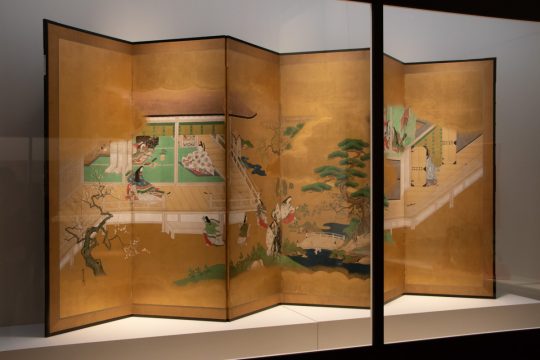
The Tale of Genji figure folding screen Kano Kanagi Edo period 17th century
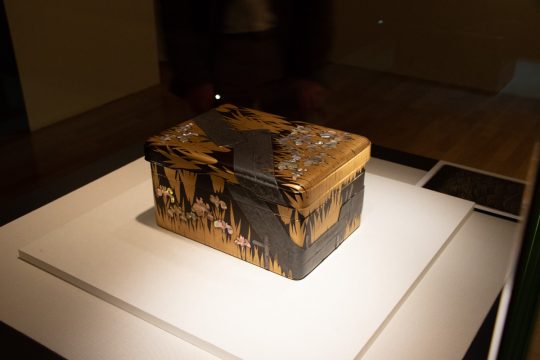
National Treasures Yahashi Makie Spiral Box Box Ogata Koin Work Edo Period 18th Century Tokyo National Museum Collection [Exhibition period: April 13 to May 6]
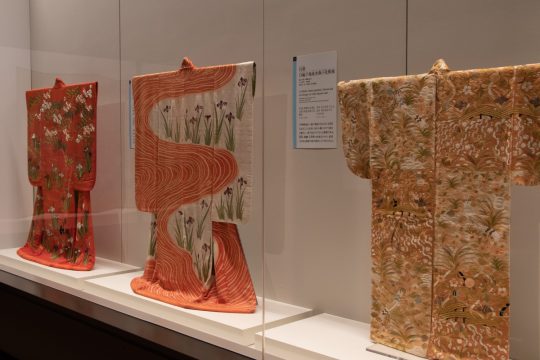
(Right) Important Cultural Properties Sewn red and white Strip strip Yabashi Snowya Yanagi pattern Azuchi Momoyama era 16th century Tokyo National Museum of Korea [exhibition period: April 13th – May 6th] (Center) Princess Hakozo Earthquake flower Yamago pattern Edo 19th century Kanagawa · Women's College of Art Museum Collection [exhibition period: April 13th – May 6th] (left) Crimson crimped area Matsukura Hatobashi pattern Edo era 19th century [Exhibition period: April 13th ~ 5 Monday 6]
Classical literature representing Japan "Ise Monogatari" and "Genji Monogatari". In this chapter, we introduce the themes of these two classical literature as a theme, the state scenes and scenes that remain in the minds of people skip over the genre of literature, and the state of cascading was taken over as paintings and crafts.
Chapter 4 Connecting motif / image
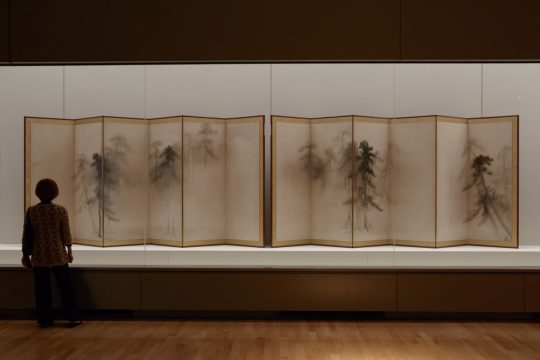
National Treasures Pine forest drawing folding screen Hasegawa etc. Akira Azuchi Momoyama era 16th century Tokyo National Museum of Korea [exhibition period: April 13 to May 6]

Lotus pond water fowl figure Kamakura period 14th century
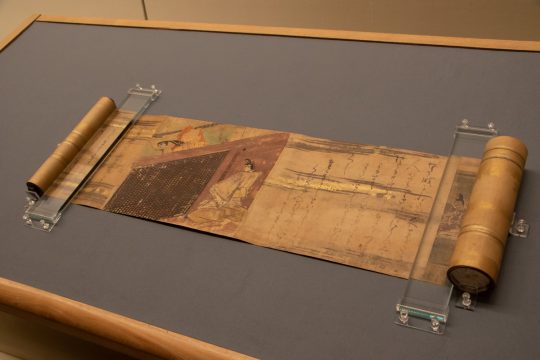
Important Cultural Property Purple Seibu Diary Picture Scroll Kamakura Era 13th Century [Exhibition period: April 13 to May 6]
In the final chapter, paintings and crafts are largely divided into the themes of "Sansui", "Flower bird", "People" and "Kokoro", and while masterpieces conveyed to the present time inherit the typing and techniques which are the norm, while introducing innovative interpretation and challenging An overview of the process that has been created by the technique.

Reimbursement Beauty figure Mr. Hisashiro Hushikawa brush Edo era 17th century Tokyo National Museum collection
How was the pose of the famous "looking beauty figure" pose, how was your eye line born? In this exhibition, we are doing a unique consideration from the point of view of "a gaze to be exchanged, a gaze to be poured". By all means, please try unraveling the mystery at the venue.
At the end of the exhibition, Tento's alumnus, acting as a voice guide for this exhibition, has appeared on the stage!
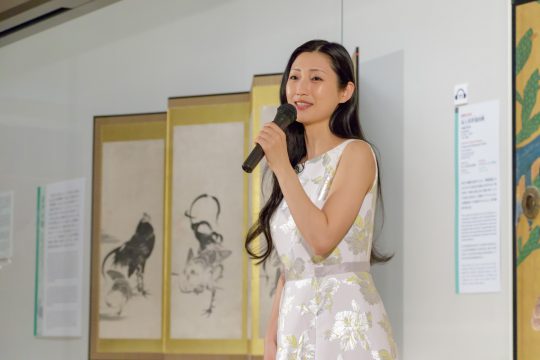
"Both pictures and statues, as well as crafts are so, it is a unique opportunity to be gathered and displayed for the commemoration celebrating 130 years since the art magazine" Kokka "was launched I think that you can taste masterpieces really close, "Do not you come this chicken" or "Fans are going to fly" with about that feeling of presence. "
I talked about the highlight of this exhibition.
"After all, finally I would like you to come to a special shop.To tote bag is recommended for me.I think that" watching "" buying "is a series of actions of intention, but this time" watching " I'd like to have "enjoy listening" during "buying" (laugh) and have fun with three elements "
In the voice guide, it seems that "dressing beauty" dubbing was also challenged, so it seems that it can be heard as an explanation option here. I am looking forward to it too!
The session will be from April 13 (Fri.) to May 27 (Sun) in 2018.
The story of creation, passed beyond time.
By knowing "connection" hidden in the work, "masterpiece" may seem more familiar.
Special exhibition "Birth of masterpieces – connecting Japanese art", why do not you go check it out.
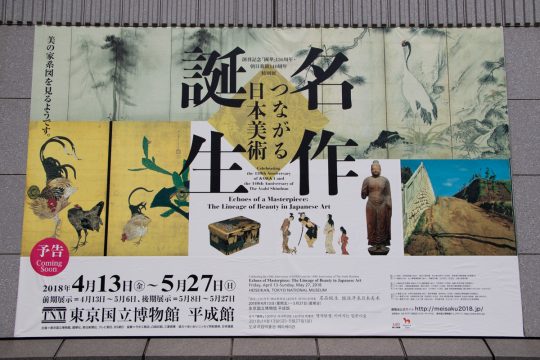
Outline summary is here
https://home.ueno.kokosil.net/en/archives/23131


